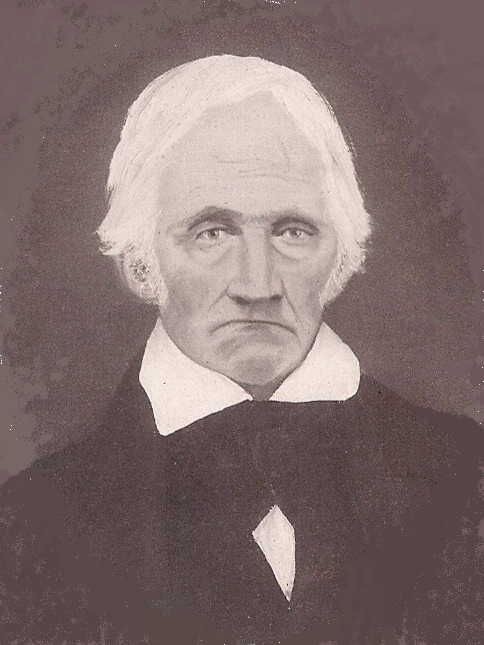Flower

Flower Swift, a fifth Great-grandfather
(artist unknown) circa 1810
"The Revolutionary War was brewing … "
In the decades following the Lewis and Clark expedition, geographers and surveyors scoured the inner-mountain West, attempting to create accurate maps of the newly discovered territory. They were able to produce credible maps, too, which were certainly helpful enough to guide the upcoming pilgrims who would soon be flooding the Plains. Genealogy seems a similar occupation, for I'm scouring unfamiliar territory, seeking the source of incoming flows. If I find evidence of an ancestor, I wonder where they originated. I spot the higher peaks, knowing that more water will likely come off them. The high peaks in genealogical research tend to be the more famous people, for their notoriety encourages more researchers to focus and, therefore, discover more incoming flows.
The highest mountain in my family's history contains the unlikely name of Flower. Flower Swift is a name repeated in at least five generations and associated with more than one lifetime's worth of adventures. The Flower Swift, a possible likeness above, is another of my fifth great-grandfathers. He was born in 1750 near current-day Frederick, Maryland, where his father, Thomas (1725-1802), worked building roads. Thomas was granted 260 acres on Sandy Creek near present-day Randolph, North Carolina, and relocated his family via The Great Road down The Shenandoah Valley, probably in the early 1760s. The Western Piedmont had recently been opened for settlement. The British government was eager for settlers to turn the land into profitable crops, so they actively enticed folks to relocate there. Thomas' claim was adjacent to a Quaker family named Husband, Young Flower, and his neighbor, Herman Husband—who would later become infamous for participating in the brief War Of Regulation, the North Carolina version of Boston's Stamp Act protests—became friends.
The British Crown's management of New World operations became increasingly corrupt in the years immediately preceding The Revolutionary War. In The Carolinas, Governor William Tryon out-sourced his tax collection to private militia and sheriffs, who routinely seized more than was owed. The settlers complained to deaf ears and eventually began engaging in active disobedience, culminating in a battle where both sides lost lives. The governor's forces prevailed, and the leaders of the uprising quickly disappeared. Herman Husband was identified as a leader. Both he and Flower Swift disappeared immediately following the battle in 1771.
Swift fled to extreme Southwest Virginia, a corner of the state the British avoided, near the Cumberland Gap. Flower married a Quaker neighbor, Mary Bedsaul, in 1777 in Virginia. He must have been extremely clever, for he managed to thrive even though he had relocated into one of the country's most remote and untamed corners. It was steep and rocky land covered with arboreal forest, unsuitable for farming. He became a blacksmith, and rumor has reported that he and his father-in-law counterfeited British coins. The immediate area featured deposits of lead and other heavy metals, so it's no stretch to imagine some silver-bearing deposits hidden there. Currency was the scarcest commodity on the frontier, but something the oppressive government nonetheless demanded from settlers. Hence, it seems like just desserts if our wayward ancestor enabled settlers to pay their oppressors with phony coin.
Records show this branch of the Swift family going back to 1579, during Queen Elizabeth I's reign. My twelfth great-grandfather, Edward Swift, hailed from Tellisford, Somerset, England. His son James (1618-1690), his grandson Flower (1649-1711), and his great-grandson, also Flower (1675-1750), also lived in Tellisford. In 1700, though, another Flower Swift was christened in Tower Hamlets, City of London. This was the one who emigrated to this continent, where he married the daughter of an emancipated indenture, Elizabeth Whitaker, in 1725 (More on her later). They had our Flower Swift's father, Thomas, in 1725, who then fathered OUR Flower Swift in 1750. There are almost two hundred years of family history in this paragraph.
The Regulators' scuffle and the counterfeiting only start Flower Swift's story. The Revolutionary War was brewing, and he would play a significant, if minor, role well off the beaten path. I'll go there next and introduce you to Captain and Colonel Flower Swift of the Virginia Militia.
©2024 by David A. Schmaltz - all rights reserved


